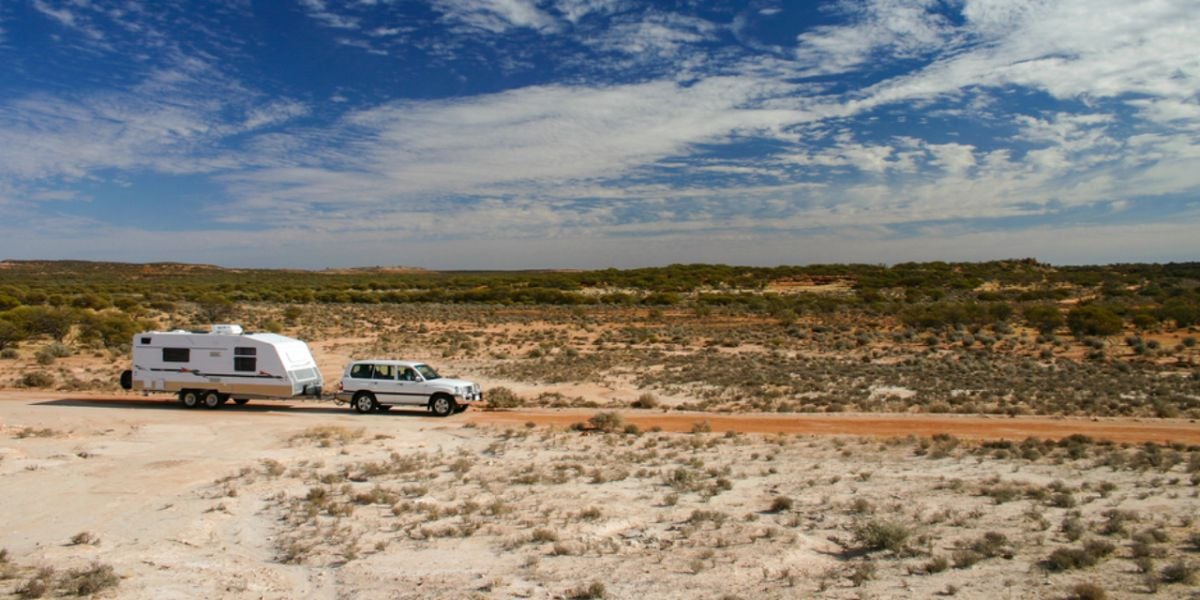
Australia is a huge country, with vast distances between its major cities and attractions scattered across every region. From remote natural wonders to vibrant urban hubs, getting around can be a challenge without the right information. This guide gives you an overview of the main ways to travel across Australia—by air, road, rail, and coach—so you can choose the mode of transport that best suits your journey.
All major cities in Australia have their own public transport network, where you can travel around town by train, tram, bus and ferry, and there are also services connecting capital cities with regional towns. However, Australians love their cars, and many people prefer to drive from A to B instead of taking public transportation. For those living in remote and rural areas, owning a vehicle is often a necessity.
Air travel in Australia
Most major Australian cities are separated by long distances, but they are easily accessible by air travel. Australian airlines and airports are modern and efficient, serving both business and personal travelers. But air travel in Australia can be costly. The best way to save money on flights is to keep an eye out for airfare sales or book your flights well in advance of your travel dates. It's also cheaper to travel outside of peak times, such as school holidays, public holidays and summer months. Airline loyalty programs are also a good way to save money on flights — earn points and redeem them for air travel (see below for more details).
Websites like Google Flights, Webjet, Skyscanner, and Kayak allow you to compare prices for domestic flights around Australia. Flights, depending on distance, can vary hugely in price. However, due to the sheer size of Australia, flying is the most efficient way to see all the country has to offer.
Australia's domestic airlines
- Qantas: Qantas is Australia's national airline, operating flights to most major Australian cities, as well as numerous regional destinations.
- Jetstar: Jetstar is a low-cost airline owned by Qantas and flies to many Australian cities and regional destinations.
- Virgin Australia: Virgin Australia is the competitor to Qantas and Jetstar. Operating flights to Australian cities and regional areas, it also offers more competitive fares than Qantas.
- Regional Express (REX): REX is a regional airline that operates nationwide flights to regional destinations.
As well as these major airlines, smaller regional airlines operate flights to more remote parts of the country, such as Airnorth, Nexus Airlines, Fly Pelican, and Sharp Airlines. It's worth noting that some airlines reduced their domestic flight schedules, increased prices, and limited some routes after COVID.
Save money on flights with loyalty programs
As mentioned above, airline loyalty programs are a fantastic way to save money on flights. Loyalty programs are usually free to join, and you can earn points to redeem for flights through everyday purchases such as groceries and petrol. Some points expire if they have been inactive for a certain amount of time, so make sure you're aware of the terms and conditions to get the most out of your loyalty program. Here are some of the most popular loyalty programs in Australia:
Long-distance train travel in Australia
Train travel is not as popular in Australia as it is in other countries. It is a slow way to travel, and it wouldn't be your first choice for getting swiftly from A to B. Train travel is popular with tourists who make the most of the longer travel times and use the slow pace to see and explore the country. You can travel partway around the country by train with trips from Brisbane to Cairns, Sydney to Perth, which spans the Australian continent from the Pacific Ocean to the Indian Ocean, or Adelaide to Darwin, which takes three days and two nights. It's a comfortable way to experience the vastness and diversity of the country, but rail travel in Australia is not a budget option. Traveling long distances by train involves hefty price tags; for instance, the Ghan journey from Adelaide to Darwin costs from AUD 2,000 (USD 1,300) up to AUD 12,000 (USD 7,800) in the low season.
Some of the long-distance rail options to check out include:
- Great Southern Rail: Great Southern Rail operates three iconic train journeys in Australia, including The Ghan; The Indian Pacific, which travels from Sydney to Perth via Adelaide and the Nullarbor Plain; and The Great Southern, which travels from Adelaide to Brisbane via the Grampians and Canberra. These train journeys offer comfortable accommodation, dining options, and onboard entertainment.
- Queensland Rail: Queensland Rail operates passenger train services across Queensland, including the Spirit of Queensland, which travels from Brisbane to Cairns; the Spirit of the Outback, which travels from Brisbane to Longreach; and the Kuranda Scenic Railway, which travels from Cairns to Kuranda through the tropical rainforest.
- NSW TrainLink: NSW TrainLink operates passenger train services across New South Wales, including routes from Sydney to Melbourne, Brisbane, Canberra, and regional destinations in New South Wales.
- V/Line: V/Line operates passenger train services across Victoria, including regional services to destinations such as Ballarat, Bendigo, and Geelong.
- Transwa: Transwa operates passenger train services across Western Australia, including services to regional destinations such as Kalgoorlie, Geraldton and Albany.
Commuter rail options in Australia
In urban areas, commuter rail trains are a great way to get around the city and surrounding towns, offering frequent services and reasonable fares. In most cities, commuters can purchase a transport card, such as Sydney's Opal Card or Melbourne's Myki card, which allows them to save time and pre-pay for their weekly travel. Some of the major commuter rail options are:
- Sydney Trains: Sydney Trains operates the suburban rail network in Sydney, which consists of 169 stations. The network serves the greater Sydney metropolitan area, including the CBD and suburbs, as well as regional centers such as the Blue Mountains and the Central Coast.
- Metro Trains: Metro Trains operates the suburban rail network in Melbourne, which serves 222 stations in the greater Melbourne metropolitan area, including the CBD and suburbs. V/Line train services connect Melbourne to regional centers such as Geelong and Ballarat.
- Queensland Rail: Queensland Rail operates the suburban rail network in South East Queensland. It serves the greater Brisbane metropolitan area, including the CBD and suburbs, as well as the Gold Coast and the Sunshine Coast.
- Transperth: Transperth operates the suburban rail network in Perth, which consists of eight train lines and 85 train stations. The network serves the greater Perth metropolitan area, including the CBD and suburbs, and regional centers such as Mandurah and Joondalup.
- Adelaide Metro: Adelaide Metro operates the suburban rail network in Adelaide, comprising six lines and 89 stations. The network serves the greater Adelaide metropolitan area, including the CBD and suburbs.
Traveling by bus or coach in Australia
Traveling by bus or coach in Australia can be a great way to save money. However, traveling long distances can take an extended amount of time as coaches often stop along the way to their final destination. A one-way ticket from Sydney to Melbourne on a Greyhound coach takes 12 hours overnight and costs AUD 170 (approximately USD 111). Tourists and backpackers might enjoy purchasing a Greyhound travel pass that allows unlimited travel for a set duration, where you can 'hop-on, hop off' at points of interest. For instance, you can get a National Whimit Pass for up to 120 days from AUD 449 (USD 295), which covers the network's 180+ stops. Or there's the East Coast Whimit Pass, which allows you to travel up and down the east coast of Australia for a maximum of 60 days from AUD 309 (USD 202).
Major bus companies in Australia include:
- Greyhound Australia: Greyhound Australia operates the largest coach network in the country. Operational in all states and territories apart from Tasmania, you'll find a map of their destinations here.
- Firefly Express: Firefly Express operates bus services between Melbourne, Adelaide, and Sydney, stopping in regional towns along the way.
- Murrays: Murrays offers luxury coach travel services to 50 major destinations and regional areas, with routes including Canberra to Sydney, Canberra to Wollongong, and Toowoomba to Brisbane.
- South West Coachlines: South West Coachlines connects Perth to popular destinations in the state's southwest, such as Margaret River, Busselton and Bunbury.
Vans and cars in Australia
Cars and vans are often the best way to explore a new area in Australia. Having your own vehicle allows you the freedom to travel and explore at your own pace. Road-tripping around Australia in a campervan is extremely popular and an exciting way to see the real Australia, enabling you to cut costs by sleeping in your van. Common itineraries drive along the east coast of the country, and the west coast is now a popular route too. You need to be very cautious about long-distance journeys and ensure you're well-prepared. Melbourne to Sydney is about 10 hours in a car — longer for food and toilet breaks — so it's best to give yourself plenty of time to get to your destination.
Cars and vans can be rented from companies throughout Australia. Popular ones include Jucy, Europcar, or Hertz, and you can hire cars or vans from the airport as well as different locations throughout the city. A cost-effective way to access a vehicle for long-distance travel is to research 'relocation' of a van deals. This service allows you to rent a vehicle at one location and return it to another. However, this will require checking for deals well in advance of your travel dates.
You can also purchase a vehicle of your own in Australia. Good websites for buying second-hand cars include Gumtree, Car Sales, and even Facebook! If you do buy a car, be wary of the hidden costs of registration, insurance, tolls, and petrol. If you commute to work by public transport or live in a large city, a car may be unnecessary. However, in more remote areas, a car is often the only means of transportation.
Good to know:
If you want to drive while in Australia, you can do so using a current and valid driver's license from your home country. However, each state and territory in Australia has different rules regarding the duration for which you can drive on an international license. If you become a permanent resident, you are required to obtain an Australian driver's license. More information about licensing can be found on the Aus Roads site.
Ferries in Australia
Apart from the inner-city ferries around Sydney, Brisbane and Perth, catching the ferry is a popular way to get to Tasmania from the mainland. Yes, you can fly across Bass Strait, but you can jump on the Spirit of Tasmania from Geelong to Devonport, too. You can also catch a ferry from Sorrento to Queenscliff, and there are ferries in the Top End that connect Cullen Bay in Darwin with Mandorah, as well as the Tiwi Islands.
Challenges of getting around Australia
Australia is the world's sixth-largest country by total area, covering approximately 7.7 million square kilometers (2.97 million square miles). To put this in perspective, it is almost the same size as the contiguous United States.
One of the most unusual aspects of traveling around Australia is its immense size and the vast distances between major cities and landmarks. For example, the distance between Sydney and Perth, two of Australia's largest cities, is approximately 4,000 kilometers (2,485 miles) by road, which is roughly equivalent to driving from New York to San Francisco in the United States.
If you're planning a road trip, you need to be prepared for stretches of road with very few towns, because being organized could actually save your life. Don't expect petrol stations and roadside amenities to be sprinkled along the road as they might be in other countries. In fact, some of the longest stretches of road between towns are in Australia. Being ill-prepared and driving long distances without access to services or facilities can put your life at risk, so it is essential to ensure you have sufficient fuel, water, and supplies for your journey.
Another thing to remember is that if you are planning to head off into remote or isolated parts of the country, you may need access to four-wheel-drive vehicles or small planes. It's important for travelers to plan their trips carefully, be aware of the long distances involved in traveling around the country, and have essential supplies on hand.
We do our best to provide accurate and up to date information. However, if you have noticed any inaccuracies in this article, please let us know in the comments section below.








